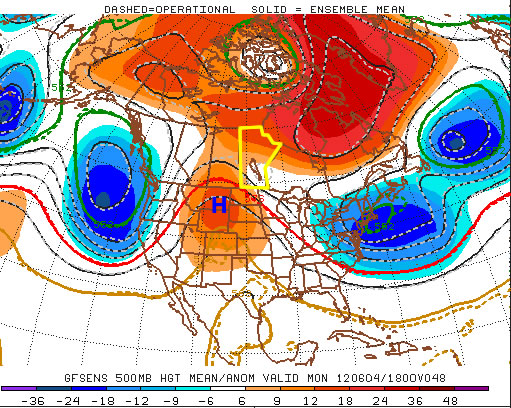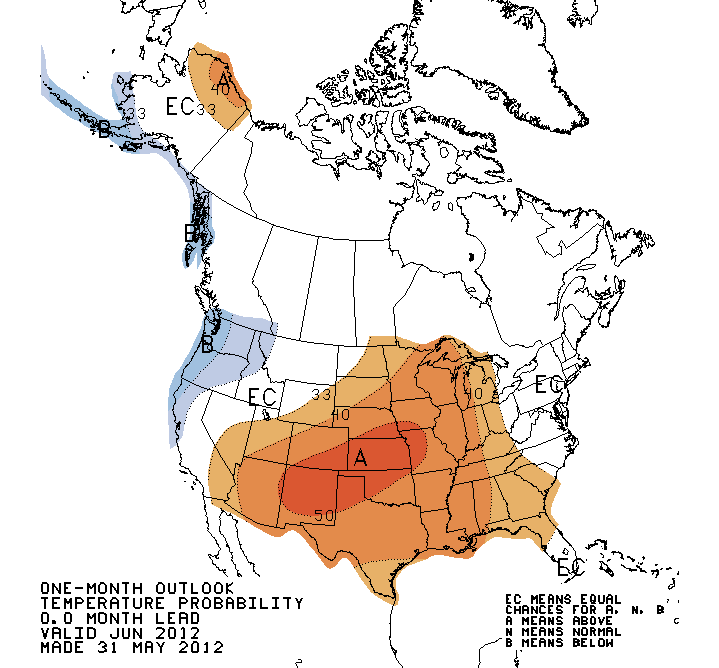Temperatures are set to soar for the remainder of this week as heat sourced from the Gulf of Mexico builds into Southern Manitoba. Residents across all of Southern Manitoba should begin to prepare for a potentially dangerous end-of-week though, as a powerful low pressure system will threaten the first significant severe weather outbreak of the season.
A southerly flow of air aloft, aided by a long-wave trough over the Rocky Mountains to our west and a blocking high to our east, will bring us our hottest days of the year through the rest of this week. Temperatures at 850mb are expected to rise to nearly 20°C today, which will result in daytime highs between 25-30°C through the second half of this week.
A weak low will move through Southern Manitoba on Thursaday night ahead of the main upper trough and while parameters don’t look too great for severe weather, a band of thunderstorms will likely develop in the late afternoon or early evening, intensify, and slowly move east-northeast. While tornadoes aren’t a likely threat with these storms on Thursday afternoon/night, CAPE values in the range of 1250-1750 J/kg combined with LIs near -5 and 20-30kt of bulk shear should provide enough for a threat of large hail. The slow-moving nature of the line of storms could potentially also produce a risk of locally heavy rainfall, with as much as 0.75-1.25” falling over a relatively short period of time. While showers will be commonplace over southwest Manitoba throughout the day on Thursday, the risk for showers does extend eastwards through the western and central Red River Valley in the afternoon. The bulk of precipitation will occur with the thunderstorms that develop in the evening, though.
This is still about 36 hours away, though, and things could change quite a bit between now and then. Models are having a hard time degrading the blocking pattern that’s in place right now, and some are much more progressive with features and some are much slower. If things end up more progressive than they look right now, there may be minimal storm threat for Thursday night.
Taking into account the various speeds, the current area that might see storms on Thursday afternoon/evening looks to be the area bounded from the US border north to Brandon, up towards Dauphin/Swan River, then eastwards across the Interlake and southwards down the eastern Red River Valley. Storms will exit through the Central/Northern Whiteshell. While the potential for heavy rainfall exists, I do not feel enough confidence in it to justify any slight risk categorization on the outlook. The storms will likely be marginally severe, though, so it’s important that they are not ignored with the prospect of even bigger storms on the weekend.
Friday looks to be another warm day; debris cloud left behind from Thursday night’s convection should clear bout by lunch time or early afternoon which will allow the sunshine to warm us up to the mid-to-high 20’s. Dewpoints will build through the afternoon pushing up to 18 or 19°C, making it feel quite humid. The main upper trough is set to move in on the weekend, though, and what a system it looks to be.
I’m not going to talk too much about Saturday’s setup yet, as it’s still a ways out and in this particular setup, the exact specifics are sure to change with every model run until it’s much closer. We’ll be under the influence of two strong shortwaves that will push copious amounts of instability over Southern Manitoba. CAPE values look to exceed 2500 J/kg and potentially be as high as 5000-5500 J/kg; this, combined with a weak cap north of the warm front and favorable shear profiles looks to point at a potent setup for severe thunderstorms with high probabilities of (extremely) large hail, strong winds, and elevated risks of tornadoes. The setup is similar to other tornado-producing setups of years past, including the Pipestone tornado of 2007.
We’ll have plenty of discussion about the upcoming storm threats in the comments, so be sure to check back often for the latest information about this weekend’s potentially dangerous storm outbreak.







